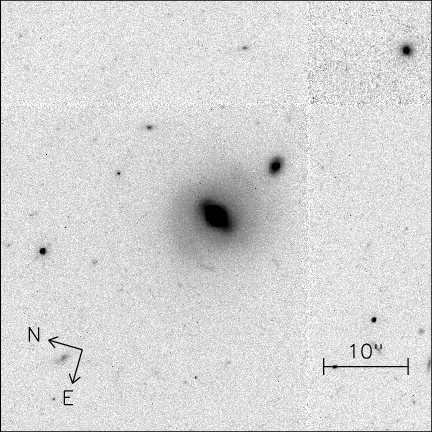







| BOOKS | F. A. Q. | ARTICLES | TALKS | ABOUT KEN | DONATE | BEYOND OUR KEN |
|---|
By Ken Croswell
January 22, 2007

Hubble Space Telescope image courtesy of Aaron Barth.
Malin 1, the prototypical giant low surface brightness
galaxy, harbors a normal disk of stars, says an astronomer in
California. A Hubble image reveals a barred spiral galaxy at Malin
1's center. As a result, Malin 1 may no longer be classified as
a low surface brightness galaxy.
Discovered in 1986, Malin 1 is the largest spiral galaxy known. Its spiral disk is 650,000 light-years across--several times bigger than the Milky Way's--but the stars are so spread out from one another that the disk looks extremely diffuse, having what astronomers call a low surface brightness.
Before Malin 1's discovery, all known galaxies with low surface brightnesses were small. They included the Sculptor and Fornax dwarfs that orbit the Milky Way. Malin 1 was the first giant low surface brightness galaxy found. Despite its diffuse light, Malin 1 emits eight times more light than the entire Milky Way, which is itself a giant galaxy. Furthermore, Malin 1 abounds with gas, containing 50 billion solar masses of atomic hydrogen gas--more than ten times the amount in the Milky Way.
Now Aaron Barth of the University of California at Irvine has accidentally discovered something surprisingly ordinary about this extraordinary galaxy. "I happened to find an image of this galaxy sitting in the Hubble archives," he says. "In the Hubble image, you can see that the galaxy has a relatively bright, normal-size, normal-brightness stellar disk that just wasn't seen in the previous ground-based data."
 Within 30,000 light-years of Malin 1's center lies a normal
barred spiral galaxy having a Hubble type of SB0 or SBa. The
galaxy's central bulge is 10,000 light-years across, and its bar
is 30,000 light-years long. The disk is smooth with no signs of
dust lanes or star-forming regions. (In the image, the line
marked 10" is 50,000 light-years long.)
Within 30,000 light-years of Malin 1's center lies a normal
barred spiral galaxy having a Hubble type of SB0 or SBa. The
galaxy's central bulge is 10,000 light-years across, and its bar
is 30,000 light-years long. The disk is smooth with no signs of
dust lanes or star-forming regions. (In the image, the line
marked 10" is 50,000 light-years long.)
"[B]ased on the presence of this disk," Barth writes in work to appear in the March 2007 issue of The Astronomical Journal, "Malin 1 does not satisfy the standard criteria for being classified as an LSB [low surface brightness] galaxy despite its having the most extended low surface brightness outer regions of any known disk galaxy."
"This is important work," says Chris Impey at the University of Arizona, one of the astronomers who originally discovered Malin 1. "It removes one mark of bizarreness from the galaxy." Nevertheless, Impey says, the enormous low surface brightness disk that extends beyond the central disk remains distinctive.
Barth calculates that 80 percent of Malin 1's light comes from that extended disk, not from the normal disk he has discovered.
Impey agrees with Barth that Malin 1 should probably no longer be classified as a low surface brightness galaxy. "I don't like to get bound up in the semantics of what's a normal galaxy and what's not," says Impey. "It's a Pluto-type argument. The way I'd put it is: Malin 1 is a galaxy that has some normal features and one extraordinary feature."
The Hubble Space Telescope was essential in revealing Malin 1's nature because the galaxy is so distant: 1.1 billion light-years from Earth. To put this figure in perspective, imagine shrinking the universe so that the separation between the Milky Way and the Andromeda Galaxy equalled the current distance between the Sun and the Earth. Then, on the same scale, Malin 1 would be more than ten times farther than Pluto. Because of Malin 1's distance, ground-based telescopes couldn't detect the normal stellar disk at its center.
The discovery means other giant low surface brightness galaxies--which are all smaller than Malin 1--may also harbor normal stellar disks at their centers. Like Malin 1, many of these galaxies are remote, so astronomers may not know the normal disks exist.
In recent years, astronomers have discovered extended disks of stars around several nearby spiral galaxies, such as Andromeda, NGC 300, and M83. Nevertheless, Malin 1's extended disk outdoes them all, being larger and possessing spiral structure. The likely reason: unlike most galaxies, Malin 1 is isolated, so no galaxy has disturbed it.
Just as Malin 1's normal disk was found by accident, so was Malin 1 itself. "We were doing a survey of the Virgo cluster, looking for faint dwarf galaxies," says Impey. "David Malin--he's the premier astrophotographer in the world--was taking these ultra-high-contrast pictures for us, and the galaxy was there on his images. So we named it after him."
Ken Croswell is an astronomer and the author of Magnificent Universe and The Alchemy of the Heavens.
"Magnificent Universe by Ken Croswell is elegant and eloquent."--Kathy Sawyer, The Washington Post. See all reviews of Magnificent Universe here.
"An engaging account of the continuing discovery of our Galaxy...wonderful."--Owen Gingerich, The New York Times Book Review. See all reviews of The Alchemy of the Heavens here.
| BOOKS | F. A. Q. | ARTICLES | TALKS | ABOUT KEN | DONATE | BEYOND OUR KEN |
|---|